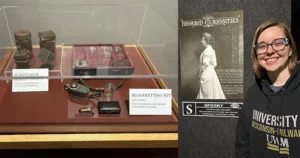The Neville Public Museum in Green Bay, Wisconsin, just wrapped up an exhibit entitled, “Morbid Curiosities.” As the name might suggest, the displays featured fascinating, arcane, and at times, even disgusting, oddities from years past. Among the items available for viewing were historical medical equipment like a bloodletting kit, mourning clothes worn by the deceased, and hair jewelry.
How does hair jewelry fit the “morbid curiosity” theme? one may ask. Isn’t it just hair pins and clips?
Well, no.
“(It’s jewelry) made out of hair,” Rose Lemerande explained.
Lemerande is the curator of the Morbid Curiosities exhibit, which she created during a summer internship at the Neville Public Museum. Curating an entire exhibit is impressive enough, but what makes Lemerande’s work stand out is that her internship wasn’t even a college internship: She volunteered at the museum before she even started classes at UW-Milwaukee.
“I was in National Honors Society in high school, and I needed more volunteer hours,” Lemerande said. “I knew I wanted to be a museum curator. I contacted the Neville and asked if they had any volunteer opportunities.”
The museum staff made her wait until she turned 18, but this summer, Lemerande got her opportunity.
Lemerande, who is now a first-year student at UW-Milwaukee majoring in anthropology, has always been fascinated by history and science. She also likes teaching people new things, but isn’t interested in teaching as a profession. Museum curation seems to be the perfect marriage of all of her interests.
Interning at the Neville Public Museum fed that love. Lemerande grew up in Green Bay and visited the Neville frequently as a child. Curating an exhibit there felt like coming full-circle, especially one like Morbid Curiosities.
“The Neville does the ‘Morbid Curiosities’ exhibit every year,” Lemerande said. “It’s items from the collection that normally you never get to see, that are creepy or weird or would just really freak somebody out. And they let me put a whole bunch of it together.”
To do that, Lemerande did research on how to curate an exhibit and took advice from her supervisors. She got lessons in how to carefully handle artifacts. Then she scoured the backrooms and basements of the museum to look for objects that fit the theme – “They basically let me take a little cart through their giant shelves of collections,” she joked.
When she finished, she had three sections of artifacts: Medicines and medical procedures no longer in use, mourning clothing worn by mourners and the deceased, and the previously mentioned hair jewelry, “which was gross,” Lemerande laughed.
Then she had to explain to the public what they were looking at. Lemerande wrote display cards and artifact labels to give each item’s specific history and description, and then bigger boards describing the overarching history of each section.
One of the most striking artifacts she displayed is a bloodletting kit, which looks like a doctor’s case lined in red velvet.
“It’s got this little block in it called a ‘scarificator.’ You would twist the end of it and a whole bunch of little blades came up at the top. It was seen as a more humane way of bloodletting,” Lemerande said.
The exhibit began Sept. 30 and ran through Nov. 5. Lemerande had the chance to visit her work in October.
All of her work has given Lemerande new insight into curation.
“There is a lot more prior research involved than I thought there would be,” she admitted. “You have to know the history behind why these items are important, why they were made in the first place, and what was done with them. That’s a lot of time and effort before you even start putting the exhibit together.”
She carries that knowledge into her UWM classes, where Lemerande hopes to explore other avenues of history. She loves curation, but she’s also interested in archaeology and biological anthropology.
Wherever she ends up, she already has an impressive entry on her resume.
“I had real work experience before I started college,” she said. “I got to look through a whole bunch of historical artifacts in the back room of a museum, which most people don’t get to do. I got to play around with a job I was thinking about for quite a while. And, I had a lot of fun doing it.”
The internship definitely helped satisfy her curation curiosity, morbidity aside.
By Sarah Vickery, College of Letters & Science
